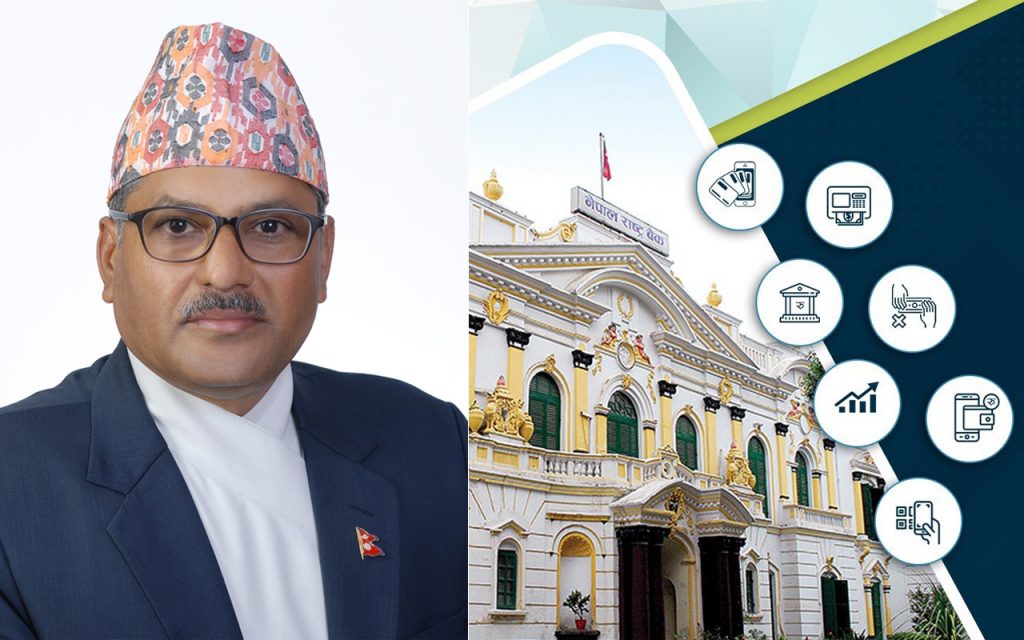Governor Maha Prasad Adhikari unveiled the monetary policy for FY 2078/79 today afternoon. Many anticipations and expectations were raised from the public and concerned authorities regarding this monetary policy. Moreover, the announcement was being postponed time and again as NRB failed to publish it on the predetermined date i.e. Shrawan 1st due to leadership changes in the government.
However, today afternoon Governor Maha Prasad Adhikari presented the monetary policy on the behalf of NRB.
Lets Look from the View of Economics First
It is a better way to start this topic through the lens of Economics. Monetary policy certainly affects technology and productive sectors too. Before that, let us know why it is formulated.
“Monetary policy is a tool to regulate the flow of monetary resources in the economy to attain certain specific objectives.”
Prof. Crowther
Indeed, the prime focus of the monetary policy is towards maintaining an appropriate level of money supply that is acceptable to the extent of the targeted inflation rate. Although the objective of launching it varies from country to country, the goal is similar:
- Achieving economic and price stability by influencing aggregate demand or spending in the economy
- Maintaining equilibrum in the balance of payments and stability in exchange rates
- Governing the banking system as a policy intervention by central regulatory authority
- In overall, controlling money supply so as to maintain a desirable level of inflation and interest rate
Well, these are the basics about “Why” regarding monetary policy. Nepal Rastra Bank has the sole authority and responsibility to publish the monetary policy as the central bank in Nepal. Today, this policy has been public and we can see many policy reforms which are essential amidst this crisis for the recovery from the Covid-19 pandemic.
Monetary Policy 2078/79; Major Provisions for Digital Economy

Apart from common macroeconomic objectives, this monetary policy has prioritized the objective of attaining digital inclusion as a part of the digital economy.
In addition to that, Governor Maha Prasad Adhikari has been also showing his leadership in linking the financial system with technology during his tenure. He was actively participating in the discussion forums like Digital Nepal Conclave. In addition to that, he has represented the readiness of NRB in fostering digital payments and banking through various instruments like PSPs, PSOs, QR code payment systems.
Have a look at the targets achieved!
As a result, we achieved some recognizable targets of the previous monetary policy:
- National Payment Switch is soon to be implemented for recording all the financial transactions on digital platforms
- NRB launched QR code guidelines for facilitating digital payments
- The QR code payments rose from Rs 590 million to Rs 1.97 billion between 2077 and 2078
- With the rigorous adaptation of digital trading systems in the capital market and other factors, Nepse Index has more than doubled from that of the previous year end
- NRB has been publishing the data regarding Payment System Indicators in a monthly basis on its official website
This year too, this policy has introduced some remarkable measures in order to maintain consistency in this pace of digital transformation.
Provisions for Digital Payments and E-banking
The policy has formulated some policies for expanding digital payment practices and e-banking transactions.
- All the banks and financial institutions (BFIs) along with infrastructure development bank should submit their financial reports and information through digital medium i.e Supervisory Information System- SIS
- E-KYC system would be implemented soon for facilitating digital customer recognition system in the BFIs
There is a lot more provision for digital payments…
- The FY 2079/80 would be more focused on developing the required infrastructures and awareness for promoting digital payment transactions in a massive way
- By this year, the National Payment Switch will exist for maintaining interoperability within the digital payment platforms
- The payment service providers and payment service operators would get to enjoy the facility regarding refinancing of loans
- NRB would timely update the transaction limits of various digital payment platforms like digital wallets, mobile banking and connectIPS
- It would further facilitate in the payments and revenue collection of government authorities and units through digital means
- Soon digital payment systems would require to tie up with microfinance and cooperatives to facilitate customers of the latter one
Moreover, it was madatory for PSPs to achieve at least 3 lakhs users and monthly transaction of 6 lakhs in number within the end of Ashadh 2078 or, their license would be dismissed. However, NRB has extended this period up to Ashadh end, 2079.
Not only that, NRB is soon formulating a “Digital Lending Framework” to facilitate online application and disbursement of loans from the BFIs.
The most notable aspect of this policy is yet to arrive!
While the world economy is getting interesting with the boom in cryptocurrencies like Ethereum, Bitcoin, Dogecoin, and others, NRB is also keen on it. NRB has ensured through this policy that it would carry on necessary studies related to the prospects of digital currency for Nepal in the form of “Central Bank Digital Currency”.
What about International Payment Gateway?
The announcement of allowing a prepaid dollar card with an annual limit of $500 gained huge momentum in Nepal. The central bank has made the most remarkable effort in facilitating international payment gateway. This monetary policy has ensured to further strengthen the usage and implementation of this facility.
Similarly, those finding difficulty in sending remittances through foreign countries in USD will soon get a way out. NRB is accessing the feasibility of this process where a possible way could be by depositing the remittance through the agency account with NRB in domestic currency. It will be providing the updates later.
In a nutshell, this monetary policy has portrayed NRB’s readiness in raising optimism for the economic recovery from the Covid-19 crisis. It has continued to waive off interbank ATM charges to the users until the ongoing impact of Covid-19 pandemic. This is a huge relief for banking customers as they can withdraw cash from other banks too without charges. Moreover, the aforementioned provisions if implemented, would surely promote cashless economy. Overall, the monetary policy seems supportive towards making an effort for digital transformation through policy formulation and implementation.






